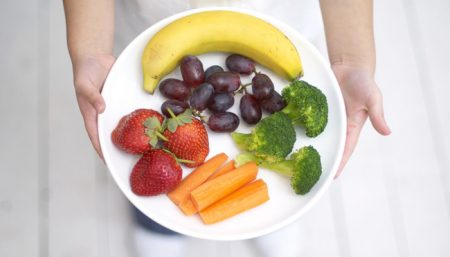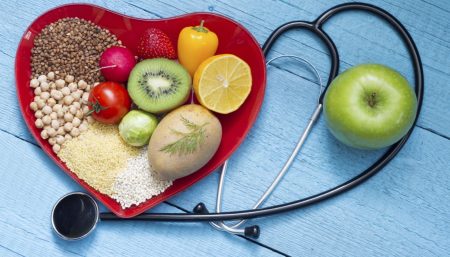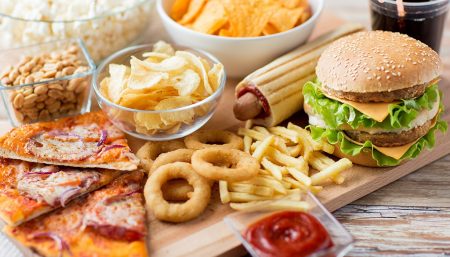A heart healthy nutrition starts with smart choices made in the grocery store. Cooking up healthy meals is a challenge in today’s, on your toes movement leaving women with no time to breathe.

Experts recommend planning meals for the week, and creating a list to shop from the market. They say it takes a few minutes, but saves time in running back to the store for missing ingredients. Tell me- Where is the time or the issue is time management.
To make things easier for You, WF nutritionist have compiled the following low-fat shopping ideas for each of the food groups.
- Fruit & Vegetables: Pick a variety of fresh and canned vegetables & fruits to toss into soups, salads, pasta, or rice dishes. Whenever possible, choose vegetables without added salt, and fruit packed in juice. Seek out local or organic produce. If you eat fruits and vegetables when they are in season, you will find that they have been picked at their best and not grown in glasshouses; they will have more flavors and generally have more vitamins, minerals and other nutrients than at other times of year. It is much better to look forward to tasting the first new potatoes or crisp orange pippins, rather than to eat the same boring food all year round. Seasonal shopping can also help to keep the cost down, as prices are frequently lower when there is a deluge of produce on the market.
- Dairy Products: Dairy foods are an excellent source of bone-building calcium and vitamin D. There are plenty of low-fat and nonfat options to help you get three servings a day, including drinkable and single-serve tube yogurts, and pre-portioned cheeses. If you enjoy higher-fat cheeses, no problem — just keep your portions small. Whole milk gets 35-45 percent of its calories from fat; 1 percent only gets 23 percent and nonfat supplies only 4 percent of calories from fat, and all of the good stuff is still left in. Almost everyone loves the taste and texture of cheese. Unfortunately, cheese is loaded with fat. Most cheeses average between 40-60 percent of calories from fat. Try a low-fat version of your favorite cheese, and/or cheeses of the part-skim variety (mozzarella, ricotta, cottage cheese, low/nonfat cream cheese, etc.). If you are used to eating regular cheeses, don’t expect low or nonfat cheeses to meet your standards at first. Eventually, you will develop a taste for a very low-fat or even nonfat version. Coming to low-fat or nonfat yogurt – it is a great food for three different purposes: a great substitute for both sour cream and whipping cream; supplies great taste and texture to many foods such as a baked potato or angel food cake; and is a great snack (especially when you add fruits such as bananas, berries, dates, etc.). Make sure to choose low-fat or nonfat varieties. Regular yogurt gets almost 50 percent of its calories from fat.

- Meat: There are really two things to look for if you want to continue eating red meat and still live a low-fat, healthy life-style: portion size and fat content. You should not eat more than three ounces of lean meat a day, roughly the size of a deck of cards. If you are eating 2,500 calories a day, you need approximately 300-500 calories of protein, or 75-125 grams of protein. Three ounces of lean meat and a serving of a dairy product will satisfy that. Meat marked “select” is the leanest (39 percent fat ). The “choice” grade has more (44 percent fat); and “prime” is the fattiest (48 percent fat). Also, when selecting ground beef, choose varieties labeled “round,” “loin,” “top sirloin,” or “extra lean” because they are the leanest. In addition to labels, check the meat itself for fat and color. Look for cuts with the least amount of visible fat. Meat with white streaks of fat is obviously going to be much higher in fat. Also, if the meat is really dark red, it is a lot leaner than meat that is pink or gray. When shopping for sandwich meats, stay away from salami, bologna, pepperoni, and bacon. Once again, try the leaner white meats such as chicken, fish, and turkey. You can also try lean versions of roast beef and ham.
- Eggs: Each egg contains 5 grams of fat and 210 milligrams of cholesterol. Consuming only two eggs a day would put you well over the recommended daily limit of 300 milligrams of cholesterol. It is also recommended that you don’t exceed four whole eggs a week. Egg whites (eggs without the yolk) are fat and cholesterol free and contain almost all of the protein. For cooking and baking, simply use three egg whites for every whole egg.
- Grains & Pasta: Choose your grains wisely. Try whole grain products for their fiber. Fiber helps you avoid cancer, helps lower your cholesterol, and helps your digestive track function properly. Try to get 25-35 grams of fiber a day. Unfortunately, fiber grams do not add up easily. Two slices of whole-wheat bread contain three grams. On average, a bowl of cereal has 2-3 grams though there are many tasty high-fiber cereals on the market. Again, read the label. A cup of enriched spaghetti contains 2-3 grams. And one bagel has 5 grams. In addition to fiber, whole grain foods also supply vitamin B and E and some trace minerals. Try to replace egg noodles with wheat or spinach noodles; this will boost your nutritional intake. Rice comes in many varieties, but the most commonly used are white and brown rice. White rice is enriched and, therefore, provides more thiamin and iron. However, brown rice naturally supplies a good source of fiber, calcium, phosphorus, and vitamin E.

- Cereals: Check the labels for those that offer less sugar and are low-fat, and that have at least two grams of fiber per serving. If chosen wisely, cereals can be a great source of fiber. Unfortunately, many cereals high in fiber are low in taste. Stock your shelves only with cereals you like. This will greatly increase the chance you’ll actually eat them. If you buy brands that you “should” eat but they taste like cardboard, chances are you’ll skip breakfast altogether. Try adding fruits to your cereal. You might even want to buy two types of cereal: one low in fat and high in fiber, and one low in fat and a little higher in sugar, to make it more enjoyable. Mix these together and you have a delicious and healthy way to start the day.
- Oils: Avoid saturated fat whenever possible and keep your total saturated fat calories to less than 10 percent of your daily food intake. Unsaturated oils come in two types: monounsaturated and polyunsaturated. Mono-unsaturated oils include olive, peanut, and canola oils. Poly-unsaturated fats include corn, safflower, and sesame oils. If you are shopping for an oil for stir-frying or baking, pure olive oil is the best. Virgin and extra-virgin oil are higher grades and are best for light sautés or for drizzling on pasta, vegetables, or bread.
Whatever your nutritional requirement, there’s always delicious normal food to be found.
Disclaimer
The Content is not intended to be a substitute for professional medical advice, diagnosis, or treatment. Always seek the advice of your physician or other qualified health provider with any questions you may have regarding a medical condition.



